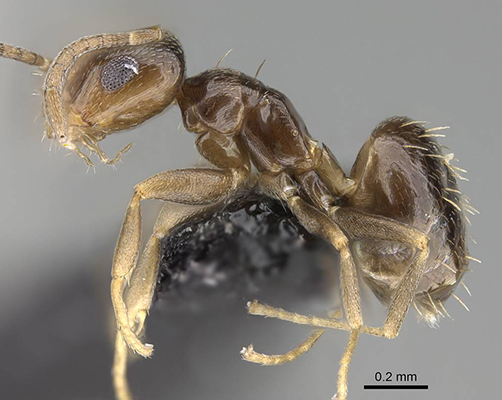
PHOTO: Michele Esposito / Image Copyright © AntWeb 2002 – 2023. Licensing: Creative Commons Attribution License
This species is native to Argentina, but has been introduced into the U.S. where it is now present in the Gulf Coast (southeastern Texas to Florida), Mid-Atlantic states, and in certain metropolitan areas of Arizona and Nevada. Workers are relatively small (0.06 to 0.08 inch), and are reddish-brown with pale tarsi and mandibles. Their antennae are brownish-yellow with nine segments, which is true of all rover ants in the Brachymyrmex genus. Per a “Featured Creature” bulletin produced by the University of Florida (UF) entomology department, this species differs from others because of its “long hairs on the mesosoma, relatively large eye (compared to other Brachymyrmex spp.), and sparseness of appressed hairs on the dorsal surface of the gaster.”
Rover ants do not sting, but they have become a nuisance in homes and other facilities because of their presence in large numbers. Alates also are produced in large numbers, and are attracted to lights at night. Per the UF bulletin, “colonies are formed in soil, at bases of trees, in leaf litter, wood piles, and rubbish heaps… In landscaped areas, dark rover ants are commonly found in mulch. Nests are also formed within man-made structures. In southern California, workers have been found in urban areas foraging on pavement adjacent to turf.
“Laboratory studies indicate a preference for high levels of moisture, and anecdotal reports indicate a tendency to invade bathrooms and kitchens,” the bulletin notes, also pointing out that “Large numbers of alates in swimming pools is another frequent problem.”
In some southern areas of the U.S., they have been collected nearly throughout the year. They nest in rotting wood and soil, and have been observed feeding on honeydew. The UF bulletin acknowledges that these ants are considered to be a hard-to-control species, and recommends eliminating moisture sources for population growth, and to consider light placement to deter alates.
REFERENCES
- EENY498, one of a series of the Entomology and Nematology Department, UF/IFAS Extension, accessed 2/17/23: EDIS.ifas.ufl.edu/publication/IN899
- Truman’s Scientific Guide to Pest Management Operations, Seventh Edition, available for purchase at MyPMP.net/shop
Leave A Comment